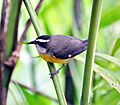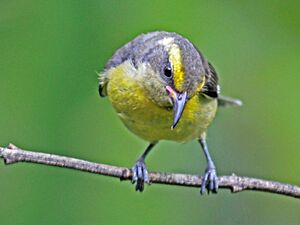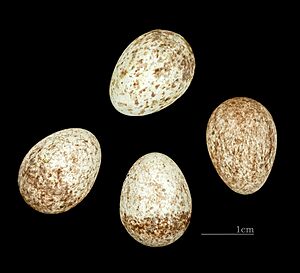Bananaquit facts for kids
Quick facts for kids Bananaquit |
|
|---|---|
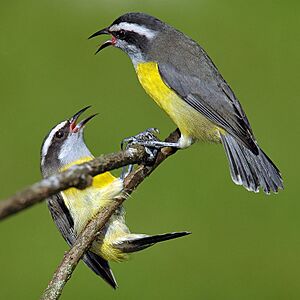 |
|
| In Campo Limpo Paulista, São Paulo, Brazil | |
| Conservation status | |
| Scientific classification | |
| Genus: |
Coereba
|
| Species: |
flaveola
|
 |
|
| Synonyms | |
|
|
The bananaquit (Coereba flaveola) is a small, active passerine bird that loves to eat nectar. You can find these birds in the warmer parts of the Americas. They are usually quite common.
Their name comes from their bright yellow color and the old English word quit. This word refers to small tropical American birds. Think of other birds like the grassquit or orangequit.
Contents
Discovering the Bananaquit
The bananaquit was first officially described by a famous scientist named Carl Linnaeus in 1758. He included it in his important book, Systema Naturae. Linnaeus called it Certhia flaveola.
Later, in 1809, another scientist named Louis Pierre Vieillot decided the bananaquit was special enough to have its own genus called Coereba. The name Coereba might come from a Tupi word for a small black and yellow bird. The word flaveolus is Latin for "golden" or "yellow."
How Scientists Classified This Bird
For a long time, scientists weren't sure exactly where the bananaquit fit in the bird family tree. Before we had ways to study DNA, it was hard to know for sure. Some thought it was related to New World warblers, others to New World sparrows. Some even thought it should be in its own unique family!
Now, thanks to molecular phylogenetic studies (which look at DNA), we know the bananaquit belongs to the tanager family. It's even related to the famous Darwin's finches!
Bananaquit Subspecies
Scientists have found many different types of bananaquits, called subspecies. These are like different versions of the same bird, often found in different places. There are 41 recognized subspecies!
These subspecies can be grouped into three main types based on their DNA and where they live:
- One group is found in Jamaica, Hispaniola, and the Cayman Islands.
- Another group lives in the Bahamas and parts of Mexico.
- A third group is found across South and Central America, most of Mexico, the Lesser Antilles, and Puerto Rico.
Some of these subspecies might even become separate species in the future!
Subspecies Gallery
-
C. f. aterrima (normal and dark types), Grenada
-
C. f. bahamensis, Bahamas
-
C. f. bartholemica, Guadeloupe
-
C. f. chloropyga, São Paulo, Brazil
-
C. f. flaveola, Jamaica
-
C. f. luteola, Trinidad
-
C. f. portoricensis, Puerto Rico
-
C. f. sanctithomae, Saint John, U.S. Virgin Islands
-
C. f. uropygialis, Aruba
What Does a Bananaquit Look Like?
The bananaquit is a small bird. Its size can vary a bit depending on where it lives. They are usually about 4 to 5 inches (10 to 13 cm) long. They weigh between 0.2 and 0.7 ounces (5.5 to 19 grams).
Most bananaquits have dark grey (almost black) backs and heads. They have a clear white stripe above their eye. Their throat is grey, their belly is white, and their chest, belly, and rump are yellow.
Both male and female bananaquits look alike. However, young bananaquits are usually not as brightly colored. They often have yellow eyebrows and throats.
Some subspecies have different colors. For example, some from the Bahamas have white throats. Others from islands off Venezuela are mostly blackish. The pink color inside their mouth is often very noticeable in birds from the Caribbean Sea islands.
The bananaquit has a special paddle-shaped tongue. This helps it drink nectar from flowers.
Where Do Bananaquits Live?
Bananaquits live in tropical South America. You can find them as far north as southern Mexico and throughout the Caribbean. They live on almost all the islands in the West Indies, except for Cuba. Sometimes, birds from the Bahamas even visit Florida!
These birds like many different open or partly open places. This includes gardens and parks. However, you won't usually find them in deserts, very thick forests (like parts of the Amazon rainforest), or high up in mountains above 6,500 feet (2,000 meters).
Interestingly, some frog species, like the Common coquí, are known to use old bananaquit nests as their homes!
Bananaquit Habits and Life
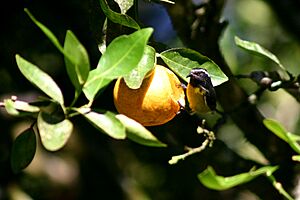
The bananaquit has a thin, curved beak. This beak is perfect for sipping nectar from flowers, including those of mistletoe plants. Sometimes, they are a bit sneaky. They might poke a hole in the side of a flower to get the nectar without helping to pollinate the plant. This is called "nectar robbing."
They also eat fruits, like mistletoe berries and ripe bananas (which is how they got their name!). They will poke holes in fruits to get the sweet juice. Sometimes, they even eat small insects like ants and flies, or tiny spiders. When a bananaquit eats, it always needs to perch on something. It can't hover in the air like a hummingbird.
Bananaquits are very good at living near people. They often visit gardens and can become quite friendly. People sometimes call them "sugar birds" because they love to visit bird feeders filled with sugar.
These birds build a round nest with a side entrance. They line the inside of the nest. The female bird lays up to three eggs and takes care of them by herself. Bananaquits are clever builders and might even build their nests in human-made things, like lampshades or garden trellises. They can breed all year round and often build new nests.









